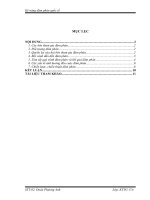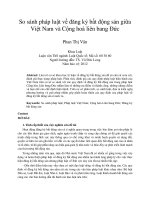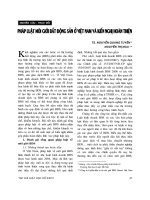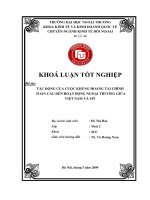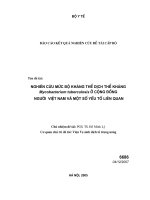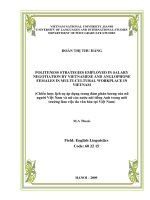Comparing Len Dong ritual of Vietnamese and Gut of Korean (the case study in Hanoi and Seoul) = So sánh nghi lễ lên đồng của người Việt Nam và Gut của người Hàn Quốc (Trường hợp ở Hà Nội và Seoul)
Bạn đang xem bản rút gọn của tài liệu. Xem và tải ngay bản đầy đủ của tài liệu tại đây (884.55 KB, 18 trang )
VIETNAM NATIONAL UNIVERSITY, HANOI
INSTITUTE OF VIETNAMESE STUDIES AND DEVELOPMENT SCIENCES
BUI LE KHANH CHI
COMPARING LEN DONG RITUAL OF
VIETNAMESE AND GUT OF KOREAN
(THE CASE STUDY IN HANOI AND SEOUL)
MASTER’S THESIS
Major: Vietnamese Studies
Hanoi-2013
VIETNAM NATIONAL UNIVERSITY, HANOI
INSTITUTE OF VIETNAMESE STUDIES AND DEVELOPMENT SCIENCES
BUI LE KHANH CHI
COMPARING LEN DONG RITUAL OF
VIETNAM AND GUT OF KOREA
(THE CASE STUDY IN HANOI AND SEOUL)
MASTER’S THESIS
Major: Vietnamese Studies
Code: 60 31 60
Supervisor: Prof. Dr. Ngo Duc Thinh
Hanoi - 2013
1
A. INTRODUCTION 4
1. The rationale, significances of the study 4
2. Literature review 5
3. Study subjects, scopes and goals 7
3.1. Study subjects 7
3.2. Study scopes 7
3.3. Study goals 7
4. Study methods 7
5. Thesis structure 8
B. CONTENTS 9
CHAPTER 1: INDIVIDUAL GUT OF KOREA FOUNDATION, THE HOLY
MOTHER IN VIETNAM AND THE CLASSIFICATION OF GUT AND LEN
DONG 9
1.1. Foundation of individual Gut in Korea and Holy Mother in VietNam 9
1.1.1. Shamanism of Korea 9
1.1.1.1. Worship the gods in the house 10
1.1.1.2. Ancestors worship 12
1.1.1.3. Worship of the village 14
1.1.2. The Mother Goddess religion (Dao Mau) in Vietnam 15
1.1.2.1. Goddess worship 16
1.1.2.2. The cult of Mother Goddess Custom 18
1.1.2.3. The Pantheon of the Mother Goddess Religion 19
1.2.1. Classification of Len dong 20
2
1.2.1.1. Thanh Dong 21
1.2.1.2. Dong Co 23
1.2.2. Gut classification of Korea 25
1.2.2.1. National Gut 27
1.2.2.2. Village Gut 28
1.2.2.3. Individuals Gut and SenamGut 31
CHAPTER 2: THE DIFFERENT AND SIMILAR BETWEEEN THE RITUAL
OF LEN DONG AND GUT (THE CASE IN SEOUL AND HANOI) 34
2.1. The way and purposes of the "ra Dong”, “moi Dong”, “di Gut” and “moi
Gut” 34
2.1.1. The way and purposes of the "ra Dong" and "di Gut" 34
2.1.1.1. In Vietnam 34
2.1.1.2. In Korea 35
2.1.2. The purpose of the "moi Dong" and "Moi Gut" 38
2.2. Worship objects, the “gia” for incarnating and the basic functions of
incarnation ritual 39
2.2.1. Objects of worship 39
2.2.2. The incarnations and the basic functions of incarnation ritual 42
2.2.2.1. The incarnations 42
2.2.2.2. The basic functions of incarnation ritual 44
2.3. The role of the Mediums, Mutang, Can dong, and Liturgical Singers (Ban
Cung van) 46
2.3.1. The role of the Mediums and Mutang 46
3
2.3.2. The role of Can dong 48
2.3.3. The role of the liturgical singers (Ban cung van) 49
2.4.1. The basic elements of the ritual 51
2.4.1.1. Clothes and tools 51
2.4.1.2. Dance and music 53
2.4.1.3. Offerings and how to display offerings 55
2.4.2. Time and space of ritual 62
2.4.2.1. Time of ritual 62
2.4.2.2. Space 63
2.4.3. The process of the len dong ritual and Gut ritual 65
CHAPTER 3: SOME ISSUES EMERGED AND FURTHER RESEARCH 76
3.1. Len Dong and Gut – way to releasing for "tie" of modern society. 76
3.2. The market trend in the ritual of len dong and Gut 81
3.3. Gender equality and women's rights issues is reflected in the phenomenon of
len Dong 88
LIST OF REFERENCES 100
WORKS LIST OF AUTHOR 104
A. INTRODUCTION
1. The rationale, significances of the study
Religious beliefs is a very important field in every culture, in relation to the
spiritual elements, reflecting the values inherited from one generation to another
generation, represents a part of the human worldview. In the morphological expression of
religious beliefs, Shamanism is a special form of religious, its formation associated with
the tribal mode.
Len dong is the most characteristic practice of the Holy Mother and Gut is Korean
Shaman's ritual. In both countries, we see many similarities in the two rites, it creates
unique features in common denominator Shamanism. In the process of learning about the
religion of the two countries in general and the Holy Mother of Vietnam, Korean
Shamanism in particular, we find that there are many similarities and differences of these
two types of religion. I chose the topic “Len Dong Ritual of Vietnamese and Gut of
Korean (the case study in Hanoi and Seoul)" to study this issue in completing and
detailing the comparison between the level of this important religious ritual. This study
hopes to contribute to provide clearer information about the len dong of Vietnamese and
Gut of Korea.
2. Literature review
There have been many studies on the Vietnamese Holy Mother and Korean
Shamanism. In Vietnam, the study of Vietnamese Holy Mother may include two
collective works "Dao Mau Vietnam" by Ngo Duc Thinh. Besides, "Len dong Journeys
of spirits, and destinies", this work is replayed one hau dong mixed reviews of the
author, and new issues are mentioned. There are also researchers such as Nguyen Kim
Hien, Nguyen Thi Hien, Le Hong Ly…
Comparing issue len dong of Vietnam and Gut of Korea in particular was
mentioned in the following three researches: Firstly, works “Khi nào Gut giống Lên đồng
vài điểm tương đồng giữa Hàn Quốc và Việt Nam” by Laurel Kendall. Secondly is the
work of Bui Thi Hoa, "Những tương đồng và khác biệt trong “Lên đồng” của người Việt
và “Gut” của người Hàn " in Journal of Northeast Asian Studies, No. 6 (112), 2010 .
3. Study subjects, scopes and goals
3.1. Study subjects
- Len dong ritual and Gut;
- Practitioners of Holy Mother in Vietnam (mediums and their disciples).
3.2. Study scopes
- Len dong ritual in Hanoi (Vietnam): Focus research resources have been
published, especially the work of Prof. Ngo Duc Thinh. In addition, the survey mainly
Len dong based in Hanoi and some its adjacent provinces;
- SenamGut ritual of Seoul (Korea): Due to funding limitations, the survey is
based on a Korean documents is mainly.
3.3. Study goals
Learn about Korean Gut platform, Holy Mother in Vietnam and the classification
of Gut and len dong.
The study focused on comparing the similarities and differences in classification,
the basic element in ceremonies and events, how the len dong and Gut. Through this
results proposed a number of issues that need further research.
4. Study methods
Retrospective method and document analysis and synthesis:
Methods of observation, survey fact:
Method comparison
5. Thesis structure
A. Introduction
B. Contents
Chapter 1: Individual Gut of Korea Foundation and the Holy Mother in Vietnam and the
classification of Gut and len dong
Chapter 2: The different and similar between the ritual of len dong and Gut (The case in
Seoul and Hanoi)
Chapter 3: Some issues emerged and further research
C. Conclusions
B. CONTENTS
CHAPTER 1: INDIVIDUAL GUT OF KOREA FOUNDATION, THE HOLY MOTHER IN
VIETNAM AND THE CLASSIFICATION OF GUT AND LEN DONG
1.1. Foundation of individual Gut in Korea and Holy Mother in VietNam
1.1.1. Shamanism of Korea
Shamanism dominated the Korean peninsula and is considered to be the state
religion until about the year 372, when Buddhism was introduced from Jin to Koguryo
and in Paekche about 384. But not when Buddhism was introduced to its heyday (in the
period after reaching three kingdom of Paekche, Koguryo, Shilla) Shamanism lost his
role in the spiritual life of the people. Nowadays, Shamanism continues to develop and
even at this stage it becomes popular with art divination. Three kingdom united, land
was opened, the temple was restored and new construction. Court and his people must
consult Shamanic practitioners about land issue. Not only have people follow
Shamanism but also members of the royal family and nobility. Shamanism still exist in
parallel with the rise of Buddhism in the sixth century. Until sixteenth century Yi
Hwang and Yi I have created two New Confucian opposition in the Korean Peninsula.
When New Confucian accepted as a religious Buddhist country, at this and other
religions are overlooked court. However the Shaman still reigns in the religious
consciousness of the Korean people until today.
1.1.1.1. Worship the gods in the house
Like the Vietnamese, Koreans believe that every family has the gods, the gods are
not the same in every house. Spirit may dwell everywhere, at home, garden, house, roof,
kitchen, toilet, barn even gods may dwell in a jar of rice, jars containers water
Although there are many gods in the house but Koreans usually conducted
worship important gods that is Chosang, Songji, Chowang, Toju, and Up. All worship the
gods of the people called Kosa. In families, mostly “Yin” gods, known as "Madam"
whose gentleness, kindness. One of the purposes of conducting the Gut ritual is for good
luck and prosperity for the family. Some gods reigned in the house owners also were
awe-inspiringly powerful by Mutang body. The gods often chosen to worship in Gut
ritual is the household god and god of fire. Unlike len dong ritual of Vietnam, Gut ritual
takes place not by Mutang organize up to an invitation from the family. Mutang conducts
for the landlord so the goddess seated in the family to pray to the gods to bring good luck
to the owner.
1.1.1.2. Ancestors worship
To commemorate ancestors Korean made three basic ritual called the Kije,
Ch'arye and Myoje. Three rituals are three types of Jesa (ancestor worship). Vietnamese
people remember their ancestors and monthly special events. They burn the followers or
offerings of food, fruit on the 1s
t
and 15
th
lunar month, major holidays such as New Year
Holiday, anniversaries, or the special days. Their place of worship is not specified any
time, depending on each family is different.
With the same concept as the Vietnamese ancestors always epiphany to bless the
children in the family so the family daily life activities such as how, when offering to
ancestors as well as those things. In some big holidays such as ancestor’s death
anniversary, New Year
1.1.1.3. Worship of the village
According to Hwang Gwi Yeon and Trinh Cam Lan (2002), from the ancient
worship of the village very much influenced by environmental factors, it dominates at the
livelihood of the villagers. Like Vietnam, people living where the worship of the village
there. Such as those who live in the mountains and prairies, tend to worship the
mountains, the coast, fishermen worship and sacrifice the dragon. Spirit dragon god
brings cooling rains for land plants in times of drought in years. At this time, it held
special ceremonies to worship the dragon god, the god of rain, may have a bumper crop
of affluence.
Village festival is usually held in the morning dawn the day in January
(according to Lunar Calendar), depending on the selected villages given to the
organization. Perform the ritual cult of the village is a special implementation of official
activities related to the village festival. These people must have the parts, and as a perfect
reputation. The gods not only protect the village bring prosperous life for people living,
but also to protect the dead in the village there. Hierarchical relationship between the
gods, from the village to the gods in the house, to the ancestors are arranged orderly in
individual Gut ritual of Korea.
1.1.2. The Mother Goddess religion (Dao Mau) in Vietnam
1.1.2.1. Goddess worship
In cosmological terms the ancient Orient, "yin-yang" is used to to describe how
polar opposites or seemingly contrary forces are interconnected and interdependent in the
natural world, and how they give rise to each other in turn in relation to each other. The
Vietnamese regarded gods: Land, Water, Mountain, Fire as Yin and with female nature,
or Mother nature.
Across the country almost anywhere has the relic worship Goddess. There are
many different goddesses with each role. The formation of Goddess worship is based on
the agricultural economy, residual social network model with a large role of the woman
in labor and production, cultural and creative combat . Goddess worship is natural forms
of human spirit. Elements in nature has an important role related, directly affect human
life, especially for the agricultural population was human mind into the "Mother" to
express the reverence , the respect of the people.
1.1.2.2. The cult of Mother Goddess Custom
The concept itself "the cult of Holy Mother " is still more heterogeneous
perspective. "Mother" is understood in a broader sense it is an honor, honored a female
character like: Au Co Mother, Lieu Hanh Mother, Mother of people Mother also refers
to proliferate, biochemical constantly of things (especially the factors that multiply its
intimately affect the lives of people) as profess Name: Mother of Land, Mother of Water,
Mother of Rice, Mother of the tree …With spiritual faith in the power of Mother - the
Creator, sponsor for the survival and growth of the universe, human nature and worship
Mother belief is seen as a template layer to The Holy of Mother and development.
1.1.2.3. The Pantheon of the Mother Goddess Religion
It might be called the dawn of the Holy of Mother is separate natural
worship Goddess. The goddesses is the god of nature and no human characteristics of
particular characteristics of the Mother. The characteristics of the Mother is manifest in
grades god, as the Au Co Mother of the Vietnamese, the Trung sisters, Y Lan Under
the background of Goddess worship and Mother Goddess, the four realms or “places”
(Tu Phu) developed. Three or four “places” here is not the number of units of the temple,
covered but three or four elements of the universe. Three realms including Heaven (thien
phu), Earth (dia phu), Water (thoai phu), the four realms include Forest and Mountain
(nhac phu).
In the Three “places” of Mother Goddess, Lieu Hanh Mother is the saint appeared
late but became the dominant deity of the Holy of Mother. She became the most major
and the most venerated figure in the pantheon and as a model for Vietnamese women.
She is considered to be the most generous sympathy gods. So she raised the most
important position, governing the gods below and the human world.
1.2. The classification of Len dong and Gut
1.2.1. Classification of Len dong
-Thanh Dong
- Dong Co
1.2.2. Gut classification of Korea
- National Gut
- Village Gut
- Individuals Gut and SenamGut
CHAPTER 2: THE DIFFERENT AND SIMILAR BETWEEEN THE RITUAL OF LEN
DONG AND GUT (THE CASE IN SEOUL AND HANOI)
2.1. The way and purposes of the "ra Dong”, “moi Dong”, “di Gut” and “moi Gut”
2.1.1. The way and purposes of the "ra Dong" and "di Gut"
2.1.1.1. In Vietnam
People are free to choose religious beliefs to follow. In Vietnam, almost no force
someone to follow religions other religions, there exists only the case due to the force of
the dominant power in time of war, or given in marriage While not of the same religion
in a religion, or by traditional family has followed religion from before. For the Holy
Mother is going to be a shamanic practitioners (mediums) or not? The answer to this
question, we have had a chance to meet with some of mediums in Hanoi and some
neighborhoods region. They tell us about the reasons and the process of "ra Dong" of
themselves. One thing is very clear that most of the people themselves do not want to
become shamanic practitioners, and a few others is by someone who is mediums and
teach their children. In Vietnam there are two ways to "ra dong". The first is due to the
voluntary and the second is due to the fate.
2.1.1.2. In Korea
In Korea, there are two typical forms of Mutang is Giang Than vu and The Tap vu.
Giang Than vu starts from mental diseases. This means that people are sick
but do not know why, just heard rumors that it was heart disease. Spirit disease will
go away completely thanks to the Gut. In contrast, if people with mental illness itself
without going Gut, the ones they will encounter difficulties and illness. That's why they
have to go Gut and accept become Mutang.
The tap vu is the way to become Mutang thanks to the transmission connector
from the previous generation to the next generation. Mostly connected from mother to
daughter. The girl mother will be participating in the ceremony and was the mother teach
the necessary lessons of a Mutang learn singing, drumming, dancing, storytelling and
personal experiences.
Thus, in Vietnam "ra dong" have two ways similar with Korea and is called
"Giang than vu" and "The Tap vu". Thereby, it is possible that the process of "ra Dong"
and "di Gut" is basically the same.
2.1.2. The purpose of the "moi Dong" and "Moi Gut"
No coincidence that the family "moi Dong" and “moi Gut” that is meaning invited
mediums or Mutang conduct ceremony for their family. There are two forms of "moi
Dong" which was invited by the group and invited individually. They "moi Dong" with
two main purposes for fortune and of power. To achieve their aspirations to continue
"moi Dong" again, this time to "do this right" (Ta Thanh).
Unlike Vietnam, the Korean people invited Mutang on major holidays for families
with three main purposes for Mutang opinions on important decisions, called spirit
ancestors and super people dead. In a Gut ritual, it is often done at the same time all three
purposes. Especially for the ceremony Gut aims to super for the dead.
2.2. Worship objects, the “gia” for incarnating and the basic functions of incarnation
ritual
2.2.1. Objects of worship
In Korea worship objects of village Gut and individual Gut is different. This is the
same between worship village tutelary and the Gods of Holy Mother in Vietnam. In
addition to the village tutelary gods, ritual objects in len dong and Gut are mostly related
to spirits in Royal. It is the glorious condition with countries such as foreign invaders and
protect the villagers, their nation.The Spirit not only is the name of the minister, the gods
are real characters but the characters are fictional folk.
The variety of objects of worship or the richness of the incarnation in the ritual of
Len Dong in Vietnam and the ritual of Gut in Korea can be explained from the
perspective of society. Because Vietnam is a multi-ethnic country with 50 ethnic groups.
Each nation has a rich system object of worship itself. Korea is the nations single,
homogeneous. So the less difference in the object of worship is also understandable.
Another difference is in the incarnation of Viet Nam does not have the appearance of
village deity as Gut ceremony. Vietnamese festival village tutelary worship on certain
days of the year, depending on each village is different.
2.2.2. The incarnations and the basic functions of incarnation ritual
2.2.2.1. The incarnations
A ritual of len dong often include multiple incarnations, each corresponding to each
of the saint incarnated his body of her actions. A len dong ceremony if mediums
preparing 36 incarnations is full. But up to now almost no case is meant enough 36
incarnations by reason of the time and space.
During the ceremony Gut Mutang will invite all the gods, but not in all gods also
descended and incarnated through the Mutang. Overview of the incarnatins of Gut, it is
divided into three categories for the gods and ancestors.There are good Gods, the god of
evil and the soul of ancestors, the deceased. Most individual Gut ceremony in Seoul
today is to escort the souls of the dead to heaven. Those family members who died
wanted to comfort their souls and control the disaster brought by the dead. This does not
appear in the ceremony of len dong and this is the clear difference in the incarnation as
well as the purpose of "inviting" in Vietnam and Korea.
2.2.2.2. The basic functions of incarnation ritual
Len dong and Gut is incarnated through the mediuma to the treatment of disease,
paying for health, fortune and luck. And the basic functions of incarnation ritual of saints
on the mediums to cure, predict and blessed fortune
In incarnation of Gut ritual notably incarnation of Bari princess. The most
important function of this incarnated to call souls ancestors and the recently deceased.
This function is very similar to the "goi hon" also known as "goi di" in Vietnam. Thus, in
addition to the formal function like the soul entering of Vietnam, Korea's Gut has another
function that is called soul ancestors, the dead and the deficit for the deceased.
2.3. The role of the Mediums, Mutang, Can dong, and Liturgical Singers (Ban
Cung van)
2.3.1. The role of the Mediums and Mutang
The mediums is considered as "the body" of the saints. On the same body can have
many saints entered. As for Mutang would like a connection between the client and the
ancestors of the guests. Mutang will demonstrate their abilities by telling customers about
the process of becoming Mutang, is how god into them. So that they can spread the word
of god and the ancestors to the customer. The Mutang act as priests, healers and prophets.
They held ceremonies to ask the gods for rain and good harvest. They read the
incantations to ward off evil spirits, trying to foresee the future of the nation as well as
the future of each individual prediction.
2.3.2. The role of Can dong
Can dong shall be considered to be those closest to medium help them prepare
almost all of the ceremony. They are the ones who understand and remember every detail
of the ceremony, even as his instructions and prompts for the new mediums. They
guessed his intention mediums needs and close coordination, quickness and rhythm with
mediums during the ceremony. In Korea people like Can dong is often unclear.
Mutang is the director and perform all the tasks that Can dong made during the
ceremony. Mutang only thanks to those of you with your profession or familiar ones of
some help if you feel the need.
2.3.3. The role of the liturgical singers (Ban cung van)
Gut ritual of the Korea does not have the liturgical singers. Mutang who performed
both singing and dancing and playing musical instruments. Therefore, before becoming
Mutang a formal way, they have to learn a lot of things, from singing and dancing,
playing music to how to perform the rituals. Korean of Mutang like real professional
actors. They are more educated than the mediums. It seems nowadays becoming famous
Mutang is known to be very difficult. Mutang must have real talent and persistence to
learn. Mutang to know both music and played many instruments, if not, must be the most
essential instrument in the ceremony is empty. But when Gut regarded as an art form to
the stage, people will see a team of musicians like liturgical singers in Vietnam, and
Mutang also play music with these musicians.
2.4. Method conducted the rituals of Gut and len dong
2.4.1. The basic elements of the ritual
2.4.1.1. Clothes and tools
In Vietnam, after "ra Dong", the mediums had to shop for her dress almost
depending on their economic conditions. Colors in costumes hau thanh be strict
compliance absolute: Heaven Realm is red, Realm of Earthly is yellow, Realm of
Mounts and Forests is blue, Realm of Water is white. Costumes are designed similar to
the resurrection of the last day or in accordance with the mind of each ethnic group.
For with Gut, Mutang costume is given by the customer. It is the concept that the offered
for Mutang is also offered for their saint. Each Mutang can have a lot of clothes from
their customers.
Costumes are indispensable elements to create a unique artistic features of the len
dong ritual and Gut ritual. In both countries bring colorful costumes, demonstrates how,
title, origin and role of each of the gods. Harmony with music, dance, clothing styles and
colors of it made the unique features within each possessed of particular and general
celebration.
2.4.1.2. Dance and music
Hat van also known as Chau van, hat bong. This is a type of Vietnamese
traditional singing, also a form of music in ritual len dong of the Holy Mother.
The music player in Gut ritual in in Seoul called "ChonAk". At Choson, Gut secret
place in the palace, so the musicians in the palace along with Mutang is true but there are
no records showing that these people are up to servants ChonAk. Today in music players
Seoul called ChonAk.
Music is one of the factors that make mediums sank in ecstasy, sublimation. With
Gut music as make the soul happy, so that the gods bless our customers. Along with the
music is the dance of the gods, that the Vietnamese often called sacred dance. With Gut,
the dances are presented in a more liberal, more motion within most done. Just like
Vietnam, in Gut dance also use tools such as swords, waving horse, flower comes.
2.4.1.3. Offerings and how to display offerings
Offerings is shown sincerity, reverence of mediums, Mutang, the follower of the
disciples to the gods. Basically both countries were offered to the gods of the basic
offerings of the followers, flowers, fruit and wine. These are indispensable at the altar.
But due to various ritual purposes in addition to those, in every country has its own
unique holiday items. All are given meaning.
When considering those who worship in the two countries we found some
common characteristics as follows: First, the offerings are colorful ceremony; second,
there is a clear delineation map ceremony dedicated to the saint; third, offerings divided
into two categories: salty and sweet.
In len dong ritual, preparing regular offerings is because the the followersprepared
if it is important, but if the ceremony by mediums self-organized annual they must be
done all. That ceremony is not required in quantity, it is up to each person. Gut, on the
other hand, ritual map is prepared by the celebrated Gut, in particular those who invited
Mutang ceremony. Mutang may require customers to prepare what the gods require the
name of the Mutang. If not, you can give money to Mutang and they will be prepared to
help.
2.4.2. Time and space of ritual
2.4.2.1. Time of ritual
At the len dong of ritual and Gut ceremony were made at that time is not constant
during the year. Gut individuals the general or SenamGut provinces of today's Seoul
particular place at any time depends on Mutang choose to worship their gods also
protected or depending on family invited to the super level the deceased. In this second
case, based on the death anniversary of the deceased or beautiful day Mutang choice. Len
dong ceremony usually takes place on several occasions during the year. Can be divided
into two time periods is the time on holidays such as: in January (known as the Le Hau
Thuong Nguyen), on July (Tan Ha Festival), December (Lunar New Year)… And locked
holidays, the time is because selected by mediums when families invite the lock such as
predestined cutting ceremony, ceremony repay the Three Jewels, the ceremony, the
ceremony almost a destiny, almost opening ceremony of the Realm
2.4.2.2. Space
The ceremony was held where is up to medium or the nature of the ceremony or
key family relationship and choose to follow the advice of mediums. For the ceremony to
be sacred and application performance, people held in temples holy church with can
mang of each medium or inviter. For example: if Co Bo, then come to (Ha Nam
province), can Quan Lon De Ngu in Tranh Temple (Hai Duong province), Gut today
celebrated stage performances and nature within the family. Location may be in the
client's home or at the home of Mutang. All steps of the ritual Gut must be conducted in a
certain space.
2.4.3. The process of the len dong ritual and Gut ritual
The process of the len dong ritual and Gut ritual of the two countries is completely
different, because the worship of the gods and the purpose of the ceremony is different.
Len Dong ritual are divided into three main stages. It's Dang so Ceremony, cung
chung sinh ritual and len dong ceremony, including len dong is the main ceremony.
According to the time order and the steps taken in a len dong incarnation can be divided
into as follows: Face covering veil, descends, burning the followers to use magic, dance,
deliver loc, listen to chau van, leaves.
SenamGut be divided into Antangsakyongmachi and SenamGut.
Antangsakyongmachi include Chutangmulrim , Pulsakori, Chongkamang, Chosangkori,
Sangsankori, Pyongsangkori, Sinchangkori, Taekamkori, Chosokkori and Changpukori.
Antangsakyongmachi mainly differs with holidays SenamGut in the ritual is carried out
only in front of the altar large put TaeAnchusang and Pulsasang. The order of SenamGut
be conducted according to the steps is: Senampuchong, Kamangchongpe, Chungtypatsan,
Sachasamsungkori, Malmi, Toryong, Munturul, Yongsil, Antoryong, Sangsik,
TuytYongSil, PeChe, SiWangKunUngKori, TuytChon .
When Gut rites ended, Mutang will blow all over the altar and sharing a bit of
fruit, cake Took to the participants.
CHAPTER 3: SOME ISSUES EMERGED AND FURTHER RESEARCH
3.1. Len Dong and Gut – way to releasing for "tie" of modern society.
If we take 1986 as the point to mark a period of change in all aspects of the
country, before it was a period of bureaucracy, people live in cramped, frustrating,
contempt, envy riches. In the thinking of the majority of people want to speed up release
of coercion, social tightening of belts. Open market economic development facilitates the
business of towels everyone. In the period of market economy, more and more people do
not have the destiny of a medium, but still build shrine and mediums’ service, because
they hope that most holy will bring fortune and health for them.
The life hurry, bustle how repressed, inhibition of modern society - urban
society which makes people to go in search of a freed and liberated. And the way to
avoid overcrowding, helplessness, lack of confidence is the spiritual world. It is the
human world to relax, get rid of every weight, o picture of daily life.
3.2. The market trend in the ritual of len dong and Gut
Developed market economy has brought many changes in society in general and
daily life of human beings in particular. Along with the outbreak of the beliefs, rituals,
that many ancient forms of religious capital of rural areas, farmers, agriculture, has
become the creed of the trade, the trader. The Mother Goddess religion rise and has been
"new blood". It is found that the invasion's strong market economy, making the religious
rituals have changed dramatically.
what we easily see that change is the number of ritual and value of it, costumes, the
liturgical singers, loc thanh , the amount of fortune was offered to the Gods, the cause in
"ra dong". Both in Korea and Vietnam currently exist in the practice of religion, but that
the public expression and is recognized in Vietnam, in Korea. Considered becoming
mediums and Mutang is a profession to maintain the economy has caused many mixed
impact on society. Considerably more hazardous is the advantage of the current situation
turbulence to profiteers, holy spirit wholesale contrary to the nature of religious belief is
good except evil direction.
In parallel with the development of economy, the rituals of religious also
somewhat modified. This creates the conditions for the inclusion of more open place,
especially in acquiring, creating unique value in special ceremonies are from the same
language to meet the needs of society. However, the negative aspects of the change in
rituals such as the "commercialize religion", "superstition", to use religious beliefs to
fraud continues in the direction most form their sophisticated. This is always a
headache issue managers and agencies.
3.3. Gender equality and women's rights issues is reflected in the
phenomenon of len Dong
In many of the studies is still a perception that women are excluded from religious
life in the village. That is only true in some cases, such as the divine system associated
with the Confucianism as tutelary village, ancestors, national heroes. Left we see a shrine
to Buddha or in the Mother temple, in which the role belongs to women. "[28,tr.193]. The
Holy Mother is not only that the right to equality between men and women, but also
somewhat more favorably with women. People still see the Holy Mother as one of the
safest cure for women, by there the gods are female. Gender equality in rights on len
dong does not stop men and women, but in this day and age of the third world, also
known as gay people involved in the len dong on a rise.
The Mother Goddess religion has helped women express their power, the power
that exists mostly in the form of "virtual power" or "spiritual power". In addition there is
also the existence of real power - the power of the family. From step into virtual reality, it
is a process of self-struggle of the first woman to win yourself and then the society to
express his desire for a better life, discharge the feeling, the pent in mind.
C. CONCLUSION
Two religions exist in two different countries, The Mother Goddess religion with
len dong ritual and Shamanism of Korean with Gut ceremony but carry a common
denominator as Shaman religion. The comparison between these two ceremonies will be
for the national identity of each country and folklore are kept to this day is still a matter
of research interest.
The Mother Goddess religion of Vietnam and Shaman religion of Korea is two
indigenous religions were formed a long time ago. The appearance of the two religions,
along with the integration of mixed religious beliefs are not the same, although the ritual
of len dong and Gut are confirmed kind of Shamanism.
Mediums and Mutang together a role that links existing between man and god
through his special abilities.
With a kind of shamanism, so in two rites of the two countries who have caught
the similarities relatively large. The difference in the new ritual to create unique features
of each ethnic group. Koreans gaze in all three of the world's past and present and future,
and the Vietnamese is not facing the world in the past but in the present. The
Vietnamese Mother Goddess religion and Korean Shamanism is the native religious
beliefs of the people of the two countries. Undeniably traditional historical values, moral
values and rich cultural values, deeply that the two religions gives residents of Vietnam,
Korea. To preserve, conserve and develop the kind of oratorio is considered the spiritual
stage, both countries are working launched the program of, different strategies that are
consistent with the spiritual life of each country.
WORKS LIST OF AUTHOR
A. Thesis-related works list
1. Bui Le Khanh Chi (2012), Xu hướng thị trường hóa trong nghi lễ Lên đồng và Gut,
Tạp chí Sân khấu điện ảnh, issue 5/2012, Hanoi, pg.52-55.
